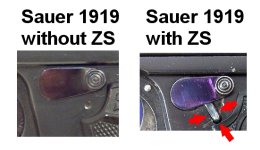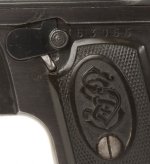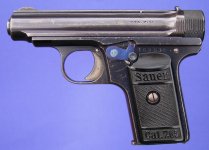Hi wordspace,
these little buggers called „Sauer“ are confusing, aren’t they?

The Sauers up to the model 38/H are like VW beetles: all do look the same but they aren’t.
OK, well, I can understand your confusion:
What I do think is unusual is that everyone who discusses the M1919 talks of it as though it is exactly a scaled-down version of the M1913, made to shoot ammunition in 6.35mm calibre (.25ACP).
Well, well, this is correct. And it is not. First of all, please always remember, that the terms “model 1913” and “model 1919”, respectively, are collector’s terms NEVER used by J. P. Sauer (as the term “beetle” never was used by Volkswagen – they called it a “type 1”). At the time the pistols were made, Sauer did not care for different variations, nor did Sauer use model names. They referred to their pistols only with “automatic pistol Sauer & Sohn calibre 7.65 and 6.35”. Distinguishing between several variations is an “invention” by collectors for collectors. It had been proven to be appropriate and convenient. What you also must know is the fact, that there is no equivalent for the first variation of the 1913. There is no equivalent model 1919 having the features of the first variation of the model 1913 (for reasons of simplification: 1913-I, 1913-II shall mean hereinafter: first variation of the model 1913, second variation, and so on).
First of all, a table of the equivalences:
Variation of M. 1913 (.32 acp).…Variation of M. 1919 (.25 acp)
1913-I………………………………………..none
1913-II……………………………………….1919-I
1913-III (with ZS)……………………..1919-II
1926…………………………………………..1919-III
OK, now….. what you have, is a 1919, third variation (1919-III) corresponding to the Sauer 1926, which sometimes is called a fourth variation of the 1913 (1913-IV). Historically, this is not correct, as Sauer in fact did name this 1926 a ….1926. Technically, this is correct: the 1926 is an improved 1913, but now looking quiet different. The appearance is something between a 1913 and a model 1930 and a Behördenmodell, respectively. Like the latter the 1926 (and the 1919-III) now did have an improved holdopen device. It is like you described it. For better understanding, I’m enclosing an image of one of my 1926s. You see? Your’s is a scaled down version of the same pistol. Well, except for the grips – but on the early variations of the 1926 the grips looked like the ones on yours (mine is a very late one).
Regarding your question:
Incidentally, I do not see this tab in the two images posted above by Sauerfan. So how do your pistols work, Martin?
Well, the 1913s and the 1919-I and 1919-II do have a lever or latch located within the trigger guard. You have to push this thing up to hold the slide open. The combined safety lever/hold open is the much better design.
Best regards
Martin



